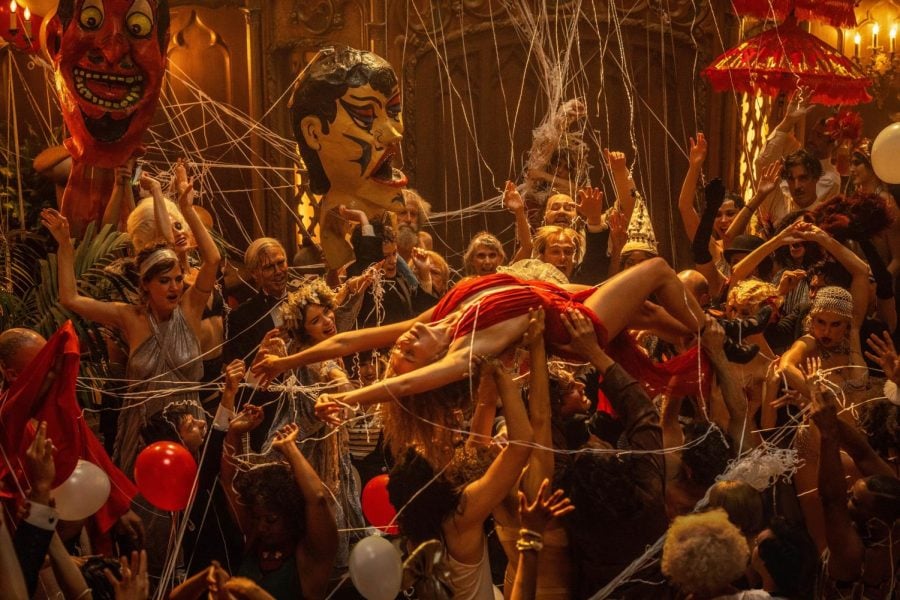Reel Thoughts: ‘Babylon’ captures the dark magic of old Hollywood in intricately messy ways
Photo courtesy of Paramount Pictures
“Babylon” was released in theaters Dec 23.
January 17, 2023
Warning: This article mentions drug abuse.
This article also contains spoilers.
“Babylon” is both a celebration of cinema and an unhinged spectacle for the origins of the industry.
The film doesn’t hit the ground running as much as it explodes from the moment that infamous party scene — a roaring rampage of debauchery and depravity — begins.
At the mansion of Jack Conrad (Brad Pitt), a young woman dies of a drug overdose and an employee is asked to dispose of her body without alerting any guests.
The solution — having an elephant burst through the mansion’s doors as a distraction — effectively illustrates the movie’s idiosyncratic pattern: Nothing is ever too extreme for “Babylon.”
If “La La Land” is director Damien Chazelle’s love letter to the city of angels, “Babylon” is his critical muse — an examination of the love and lust, allure and darkness that defined the early days of Hollywood.
Pitt, Margot Robbie and newcomer Diego Calva play the film’s three main characters. Pitt portrays a studio executive whose reputation in the industry is slowly crumbling, and Robbie an actress infatuated with being a star. Calva plays a production assistant with dreams of making movies of, as he says, making “something that lasts, that means something, something more important than life!”
This pursuit of fame turns into a delicately woven obsession that leads Calva’s Manny Torres and Robbie’s Nellie LaRoy to significant career success — but with devastating costs.
Underground speakeasies full of wild alligators, post-event snake fights and death threats from dangerous people seem to follow the main characters’ every move. Soon after, LaRoy is found dead in her hotel room at 34 years old.
Calva is excellent as Manny, rivaling Robbie and Pitt with the aplomb of a veteran actor and rewarding Chazelle’s instincts with an evocative performance set to put him on the map. He has a beguiling naivety to pair with the eyes of a dreamer, the latter suiting him perfectly for his role and for this story.
After all, in its expression of gripping ambition, “Babylon” is loud in a way that forces you to keep watching. It’s hard not to become entranced in the score by Justin Hurwitz, arresting cinematic aesthetic and harrowing depiction of the lengths some will go in search of fame.
The subtextual caution at the heart of this film will remind audiences of a different story, one about a young jazz drummer at Schaffer Conservatory. Yet in “Babylon,” the brilliance Chazelle displayed with “Whiplash” and later “La La Land” is compressed in an incompressible tonal mess of an explosively crafted 1920s Hollywood.
That much is expected for a production of this size and scale. This is a mammoth of a film, and even so, Chazelle does an admirable job of both framing a sensory-engrossing depiction of the city’s not-so-golden “Golden Age” and shedding some light on characters clearly inspired by the Anna May Wongs and Joan Crawfords of the era.
“Babylon” challenges the historical exclusion of Black and Latine filmmakers and actors by bringing characters of color to the forefront of highly anticipated pictures and “talkies” (‘20s-style cinema) within the film itself. Yet in another sense, race itself is never addressed with eloquence in the film. The struggles of Manny Torres or Sidney Palmer to make it to the top — as well as the obstacles and prejudices people of color in the industry still face today — are treated as if they never existed.
One scene invoking blackface — a depiction of a Black musician forced to apply makeup on set to alter the complexion of his skin — is shakily developed and never returned to — something you’d wish was accomplished in a film spanning more than three hours. This signals either a lack of awareness for the immoral nature of the requested face paint or a lack of desire to actually delve into issues of racism with much nuance.
There are flames of unquestionable passion in Chazelle’s characters, namely firecracker Nellie proving everyone in her entire life wrong, or Jack Conrad meditating on the sublimity of cinema in connecting people across socioeconomic status and class. But Calva’s real life story of falling in love with movies as a child in Mexico feels more moving and real — probably because it is — than any single character in “Babylon.”
Email: [email protected]
Twitter: @andresbuena01
Related Stories:
— Q&A: Sarah Polley, writer and director of “Women Talking,” discusses her creative process
— Reel thoughts: ‘Devotion’ is a tribute to the story of Jesse Brown, America’s first Black Aviator


